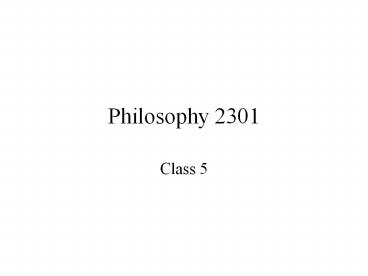Philosophy 2301 - PowerPoint PPT Presentation
Title:
Philosophy 2301
Description:
Hypothesis: Feeding oat-bran to swans will make them grow much bigger than they otherwise would. ... Proving Universal Hypotheses (All swans are white) ... – PowerPoint PPT presentation
Number of Views:16
Avg rating:3.0/5.0
Title: Philosophy 2301
1
Philosophy 2301
- Class 5
2
Admin
- Tests are in the process of being marked- still
need to have the make-up midterm.
3
Upcoming topics (for essay)
- Already discussed
- Various Problems of Discovery
- Various Problems of Evaluation/Justification
- To be discussed
- Problems of Causation (Hume)
- Positivists, Logical Positivists(Comte, Hempel)
- Duhem-Quine Hypothesis (Realism/Anti-Realism)
- Karl Popper (Truth and Falsity for hypotheses)
- Kuhn (Paradigm Shift, Relative Truth of Science)
4
Inkshedding
- What have you learned in this class, so far, that
has made you think about science in a different
way?
5
Last Few Classes
- Problems with inductive logic
- Recall where this fits in
- Problem of Discovery
- Problems of Evaluation/Justification
- Problems of Explanation
6
Humes Challenge
Hume (1711-1776)
- Empiricist
- Sceptic
- Philosopher of Science
7
Causation
- properties of objects give them causal powers.
- one event can cause another.
8
Scandal of Philosophy
causation
?
inductive logic
9
Head in the sand?
10
Group Discussion Question
- What do you think about Humes problem with
causation? Can you see any way around it for
science, or are you convinced by Hume? - On the board
- Yes- Why? (a sentence or two)
- No- Why? (a sentence or two)
- If you cant decide, do both
11
Patching up causation
12
The Soup Problem
- Possibility 1. The presence of the antecedent
circumstance in common is just coincidental
13
The Soup Problem
- Possibility 2 The circumstance causing the
phenomenon is not considered and therefore not
added to the list of circumstances to be
considered
14
The Soup Problem
- Possibility 3 The phenomenon is caused by a
combination of circumstances, not just one
circumstance in isolation-
15
The Soup Problem
- Possibility 4 The phenomenon of interest is
being caused by multiple antecedent circumstances.
16
Experiments!
- The deliberate, controlled manipulation of
nature, in an effort to generate the phenomenon
of interest. - Hypothesis Feeding oat-bran to swans will make
them grow much bigger than they otherwise would.
17
Experiments
- some knowledge of the populations
- randomly choose members of the populations
- rule out other possible causes two groups- the
control group and the test group. - hypothesis operationalized made observable and
concrete.
18
Goodbye Problems of Justification/Evaluation!
- Problems with direct observation (Galileo and
Objectivity) - Problems with auxiliary hypotheses (Copernicus)
- Problems with induction
- Proving Universal Hypotheses (All swans are
white) - Statistics and Statistical Assumptions (Average
Age of Students) - Humes Problem of Causation
- Other Problems with Induction and Causation (The
sick soup example)
19
The Problem of Explanation
- So far- observational science
20
Robert Boyle and the Gas Law
- Pressure k/volume
(1627-1691)
21
Theories
Explanations which seek to describe the
underlying causes and entities of nature in order
to explain specific phenomenon.
22
Unobservable phenomena
?
23
John Dalton
24
From the observable to unobservable
- We want to explain observable phenomenon.
- But sometimes the objects involved in phenomenon
aren't themselves directly observable. - So we require a way to connect the unobservable
objects to the observable world.
25
Internal Principles and Bridge Principles
- Internal principles describe unobservable
entities- their properties and their behaviours. - Bridge principles explain the connection between
the unobservable entities and observable
behaviour.
bridge
26
Dalton and Bridge Principles
- ?Internal Principle Atoms are not divisible
- ?Internal Principle Atoms combine to form new
compounds. - ?Internal Principle Combinations can only occur
in certain ways. All combinations involve small
whole number ratios - ?Bridge Principle pure material is composed of a
certain type of atom. The volume and weight of
the observable material are determined by the
number and type of atoms that compose that
material - Prediction If two pure materials are weighed,
allowed to combine to form a new material and the
material left over is weighed to determine how
much of each has combined, the ratio of weights
will be composed of whole numbers.







![❤[READ]❤ Primal Philosophy: Rousseau with Laplanche PowerPoint PPT Presentation](https://s3.amazonaws.com/images.powershow.com/10045057.th0.jpg?_=20240601064)























